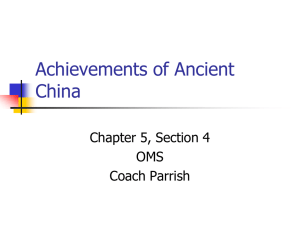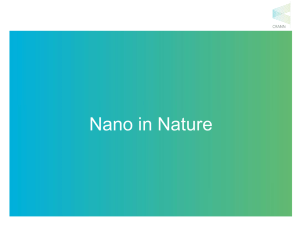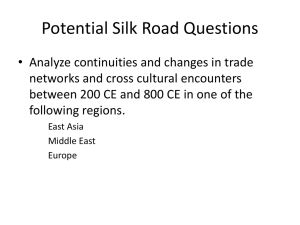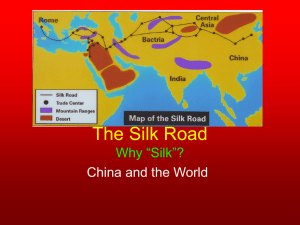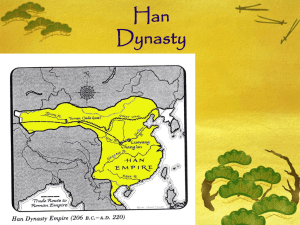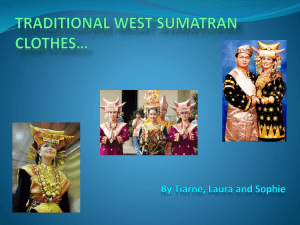The Elaborate Structure of Spider Silk
advertisement
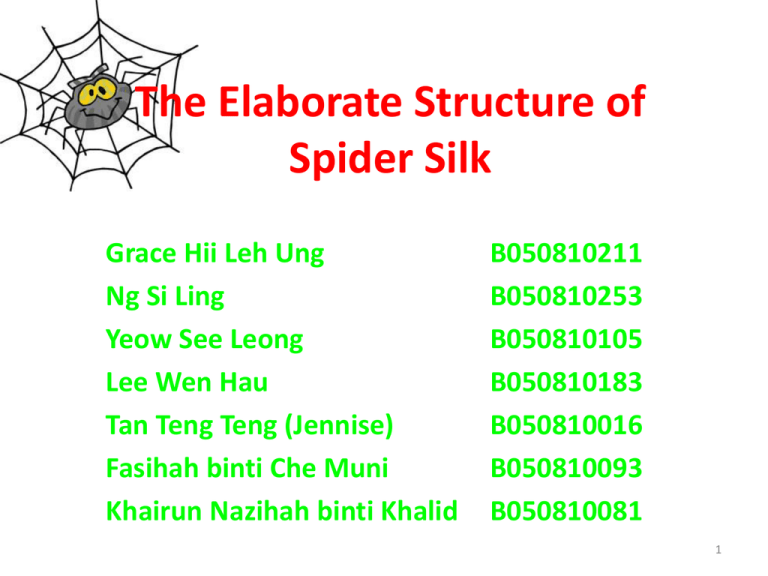
The Elaborate Structure of Spider Silk Grace Hii Leh Ung Ng Si Ling Yeow See Leong Lee Wen Hau Tan Teng Teng (Jennise) Fasihah binti Che Muni Khairun Nazihah binti Khalid B050810211 B050810253 B050810105 B050810183 B050810016 B050810093 B050810081 1 Introduction Outstanding mechanical properties Antimicrobial & hypoallergenic Spider Silk Fiber Eco-friendly & sustainable nature Unique self assembly 2 Introduction (cont.) Strong interest in advanced composite industry. Ultra-lightweight fiber that combine enormous tensile strength with elasticity. Each fiber stretch up to 40% of its length and absorb hundred times as much energy as steel without breaking. High antimicrobial and hypoallergenic properties lead to low infection rate from inflammation and allergic reaction in application of biomaterials. 3 Different silk types produced by female orb weaving spiders (Araneae). Each silk type (highlighted in red) is tailored for a specific purpose. Eisoldt,L., Smith,A. and Scheibel,T., 2011. Decoding the secrets of spider silk. Materials Today, Vol. 14, no. 3, pp.8086. 4 Drag-line Silk Used by spider for frames of their webs and as safety lines. Structures: Made up of crystalline regions of anti-parallel ß-sheets and “non-structured amorphous regions (coiled coil, performed ß-sheets and elastic ß-turn spirals). Crystalline arrays responsible for stiffness of fiber. Amorphous regions (55 to 60% of dragline spider silk) more-or-less kinetically free and change shape under influence of external load and through entropic elasticity 5 Properties: Stronger than high tensile strength steel and approaches stiffness and strength of high performance p-aramid fiber KEVLAR (widely used in bulletproof vests). Higher toughness due to greater extensibility. Torsional dampening behavior. When dragline thread twisted, it does not oscillate around the new position, like a Kevlar fiber would. After a while, fiber slowly returns to its initial position shape memory within fiber. Ability to undergo supercontraction. When dragline silk is wetted, or when the relative humidity is above 60 %, a silk thread swells in diameter and shrinks in length by about 50 %. 6 Primary Structure of Spider Silk • Primarily consists of protein that possess large quantities of non-polar and hydrophobic amino acids (glycine or alanine). 7 Primary Structure of Spider Silk (cont.) • Furthermore, it contain highly repetitive amino acid sequence (>90%), especially in their large core domain. • Composed of short polypeptide stretches of about 10-50 amino acids. • Can be repeated more than a hundred times within one individual protein. 8 Primary Structure of Spider Silk (cont.) • MA and Flag silks contain up to four typical aligopeptide motifs:[I] (GA)n/(A)n, [II] GPGGX/GPGQQ, [III] GGX (X = A, S or Y) and [IV] “spacer” 9 Primary Structure of Spider Silk (cont.) • Nonrepetitive regions are located at the protein’s termini (comprise approx. 100-200 amino acids) • The N-terminus (NRN –domain) refers to the start of a protein or polypeptide terminated by an amino acid with a free amine group (-NH2). • The C-terminus (NRc –domain) is the end of an amino acid chain (protein or polypeptide), terminated by a free carboxyl group (-COOH). • Due to cysteine residues, Intermolecular disulfide bonds stabilize these tertiary structures of proteins. • These domains are thought to initiate and specify assembly of silk proteins. 10 Primary Structure of Spider Silk (cont.) • The primary structure shows a specific hydrophobicity pattern with alternating hydrophilic and hydrophobic blocks in their core domain. • Such amphiphilic (have both hydrophobic and hydrophilic domains) composition is reminiscent of surfacetant or biological membranes. • For the case of spider silks, it is important for phase separation during the spinning process. • Amphiphilic pattern might be responsible for formation of micelles postulated as intermediate structures during thread assembly. A droplet of water forms a spherical shape to minimize contact with the hydrophobic leaf. 11 Model of the Silk Spinning Process 12 • Highly Concentrated (Monomers ) Spider silk protein solution is secreted Spinning and stored inside the spinning gland. gland • Phase separation take place when aligning in one direction through a Spinning narrow ion exchange channel- formation liquid crystalline behavior of the Duct spinning dope. • Loss of solvent the conformation conversion is finalized –silk fiber is Spinning drawn out to form silk thread. wart 13 • Assemble into small micelles with a diameter ~ 100-200nm due to amphiphilic properties inside the spinning dope. Spinning • Multimerization occurs forms a globules in micrometer range. gland Spinning • Through laminar force , the shear force increase due to narrow channel. Duct Spinning • Force these globules into an elongated shape-formation of fiber (silk thread). wart 14 Mechanical Properties • The most outstanding property of spider silk maximal resilience • Able to absorb energy 3X more than Kevlar • Kevlar is one of the sturdiest material. 15 • Resilience the ability of a material to absorb energy when it is deformed elastically and release that energy upon unloading. • Resilience = area under the stress-strain graph 16 • Spider silk : well-balanced between strength & elasticity 17 • Synthetic fibers higher stiffness & strength than natural fibers • Natural fibers tend to be more elastic • Synthetic carbon fibers: yield point > 5X higher than the best insect silk. 18 Mechanical properties of spider silk from Nephila clavipes compared to other structural materials. Material Strength (Nm-2) Elasticity (%) Energy to break (J kg-1) Dragline silk 4 x 109 35 1 x 105 Flagelliform silk 1 x 109 >200 1 x 105 Kevlar 4 x 109 5 3 x 104 Rubber 1 x 106 600 8 x 104 Tendon 1x 109 5 5 x 103 Nylon, Type 6 4 x 107 200 6 x 104 Fischer,R. and Schillberg,S., 2006. Molecular Farming: Plant-Made Pharmaceuticals and Technical Proteins. Germany: John Wiley & Sons, p. 172. 19 • Spider silk shows high supercontraction!! Absorption of water 50% shrinkage and behaving like a weak rubber under tension tightens the thread ensure rigidity Stronger, stiffer, less extensible and better able to recover after being stretched The presence of MaSp2 rich in GPGXX motifs increases the capacity of MA silk to supercontract Water disrupts the hydrogen bonds that hold the GPGXX motifs and 310 helices within the silk parallel the GPGXX motifs and 310 helices rearrange to a lower energy state and the fiber loses its orientation 20 Highest Performance Spider Silk • The toughest known spider silk is produced by the species Darwin’s bark spider (Caerostris darwini) • Average toughness = 350 MJ/m3 with some samples reaching 520 MJ/m3. • C. darwini silk is more than twice as tough as any previously described silk and over 10 times tougher than Kevlar 21 Darwin’s bark spider (Caerostris darwini) 22 Mimicking Nature Define as evolve to share common perceived characteristics with another group, the models. The evolution is driven by the selective action of a signal-receiver, or dupe. The signal-receiver is typically another intermediate organism like the common predator of two species, but may actually be the model itself, such as a moth resembling its spider predator. 23 1. Recombinant spider silk Method Direct transformation of original or fragmented silk genes into bacterial hosts. Depends on gene encoding a protein from one organism being transferred into a production host such as the bacterium Escherichia(E.) coli. Spidroin genes have an extreme codon bias, with only a subset of available codons being used. 24 1. Recombinant spider silk (cont.) Issues 1. Homologue recombination in many hosts, which removes repetitive sequences which resulted in extremely low yields of the intended protein. 2. Direct transformation of original silk genes and silk fragments is not the method of choice for recombinant spider silk production. Solutions 1. genes coding were generated using a cloning strategy which is based on a combination of synthetic approach. 2. Over-expression of the gene in bacterial hosts encoding DNA which increased DNA level, it is possible to achieve much 25 higher silk gene in E. coli. 2. Artificial spinning of spider silk Made of hundreds of tubes coming from silk glands called major ampullate and minor ampullate, and the number of glands of spider varies with species. Due to availability of recombinant spider silk proteins, scientists able to analyze assembly of spider silk threads in a functional in vitro spinning process in the near future which ensure the generated silk fiber resembles natural silk in its microstrucuture, chemical, composition and mechanical properties. 26 Method 1. Wet-spinning processes employed with promising results. Using silicon micro-spinnerets, several meters of insect or spider silk fibers produced. Natural and artificial spinning ducts. 27 2. Artificial spinning of spider silk (cont.) 2. Special Postspinning techniques yielded silks even larger diameters. But, the best mechanical properties obtained by artificial spinning techniques are much lower than natural dragline silks. 28 … Q & A … 29 1. What are the applications of spider silk? • Military: bulletproof vest Polymer science. Eg: polycarbonate (PC)-improve with adding of spider silk. High toughness Able to dissipate energy at high strain rates Ultimate tensile strength Elongation Spider silk PC 11 GPa 72 GPa 27% 6% 30 • Medical: wound healing Minimal risk for infection or disease transmission Biocompatibility for implanted material (implantation) Immediate ligament stabilization 31 • Construction: Scaffolding Lightweight High toughness High strength Can stand with temperature in below -40°C up to 220°C 32 2. Why goat is chosen in producing spider silk? • Not many differences between the silk glands of spiders and the milk glands of goats, it should be very easy to produce the silk in goats milk. 33 3. How to produce spider-goat silk? • The silk-making genes of a spider and the genome of goats is spliced. • The genes were altered to only turn on in the mammary glands of female goats that are lactating. • Using cloning techniques they have bread goats that have the spider genes, produce female goats that have the silk gene and can produce the silk in their milk. • When the milk is produced the silk proteins will be isolated out of the milk, and purified, this produces a whitish liquid that can then be spun into fibers and used for the many applications. 34 35 References Fischer,R. and Schillberg,S., 2006. Molecular Farming: Plant-Made Pharmaceuticals and Technical Proteins. Germany: John Wiley & Sons, p. 172. Eisoldt,L., Smith,A. and Scheibel,T., 2011. Decoding the secrets of spider silk. Materials Today, Vol. 14, no. 3, pp.80-86. Ciement,G., 2011. Fundamentals of Space Medicine, Second Edition. London: Springer, p.69. 36 J. M. Gosline, P. A. Guerette, C. S. Ortlepp And K. N. Savage. (1999). The Mechanical Design Of Spider Silks: From Fibroin Sequence To Mechanical Function, p. 3295-3303 Cecilia Boutry and Todd Alan Blackledge. (2010). Evolution of Supercontraction In Spider Silk: Structure–Function Relationship from Tarantulas to Orb-Weavers, p. 3505-3514 Mark J. Bonino. (2003). Material Properties of Spider Silk, p. 21-54 37 38


